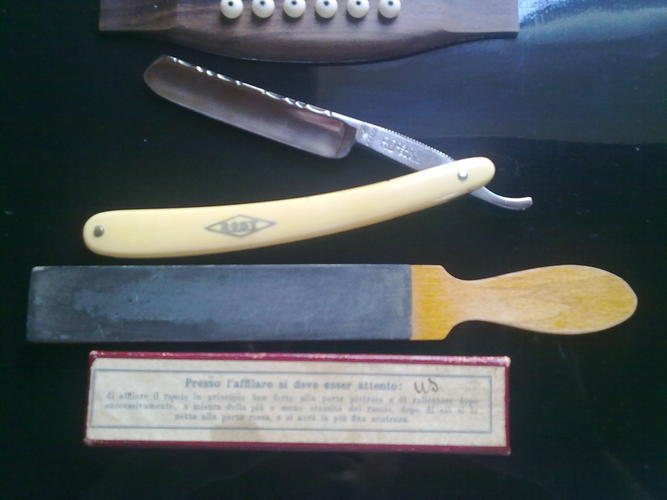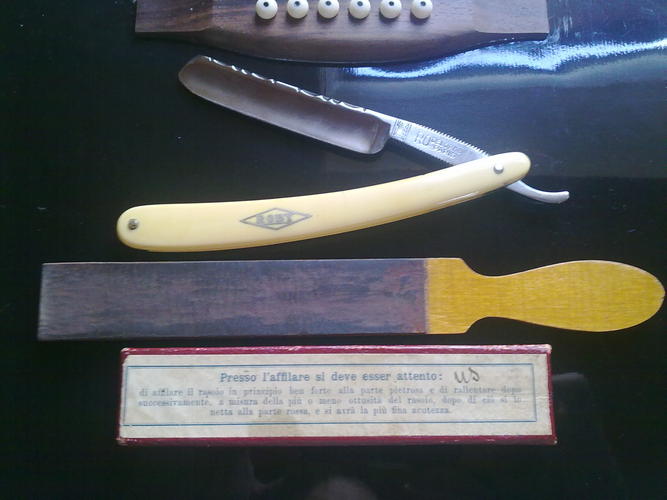Results 1 to 6 of 6
Thread: Historical Question
-
06-16-2011, 03:15 AM #1Junior Member

- Join Date
- Apr 2011
- Location
- Murfreesboro, TN
- Posts
- 26
Thanked: 2 Historical Question
Historical Question
I'm new to all this so I might be asking a stupid question, but what did a typical sr user use to hone his razor 125 years ago or so? We have all these modern stones and such that the typical person didn't have back then.
I know of Arkansas stones and the like but I doubt the typical man, especially in a rural area, had a battery of hones. Perhaps that's why so many had beards, but some did shave. I inherited a Case that my grandfather used sometime around 1910 and forward till he started using a safety razor. I'm pretty sure he never had a beard. The razor was in decent shape but I wouldn't have tried to shave with it. The only thing I know for certain was that he had a leather strop.
-
06-16-2011, 03:22 AM #2

They used Arkansas probably but going by old barber manuals they also had access to imported natural stones such as the Belgian coticule and the German Thuringan stones such as the Escher, Hohenzollern and others. Moler's Barber Manual circa 1911 talks about those stones in his book. They also had synthetic barber touch up hones such as the Swaty. The natural stones mentioned above, and many others, were well used by our forefathers here in the USA and around the world.
Be careful how you treat people on your way up, you may meet them again on your way back down.
-
06-16-2011, 03:23 AM #3Senior Member

- Join Date
- May 2011
- Location
- Cowra, New South Wales, Australia
- Posts
- 579
Thanked: 46
Some old strops came with "carborundum" on one side, I'd guess for "sharpening" the razor. One I bid on (but missed) on eBay even had the sides marked to show which had been treated and which was for finishing.
-
06-16-2011, 04:20 AM #4

Gllh,
You're very lucky to have an ancestor's blade. To avoid feeling badly about it in the future, I would recommend NOT using it to learn honing. You can't undo all the mistakes one makes when learning. If you wish to use it (I sure would), maybe invest in a honemeister's edge. If $$ is an issue, pm me. If its in good enough shape to use it, you'll be glad you kept it that way.
'Grats on coming into a treasure, and all best with your journey.
-
06-16-2011, 02:44 PM #5

We live in a disposable society where things are cheap and often times discarded. Back in the day items were made to be used indefinitely and most folks had a hone or two lying around. if they didn't want to do it themselves they could take it to a local barber or a sharpening shop or back to a razor retailer or use an itinerant peddler who sharpened. it was far easier to maintain a razor back then as opposed to now even with all the hone choices these days.
No matter how many men you kill you can't kill your successor-Emperor Nero
-
08-08-2011, 09:29 AM #6

Few days ago I got this "sharpening tool" in my mail, just won on Ebay one week ago (I still wonder why nobody bid on it but me...).
I took pictures together with a razor to give an idea of the size. It has a very smooth stone on one side, and leather on the other. The leather seems to have been treated with some red powder to improve its grinding (?) skill.
We can date it by two things on the box: fistrly, ther are the letters "us" handwritten, and they have been written with ink and pen, so we can say it's older than 1950 (at the latest). The second thing is the instructions, which are in Italian, and translated in English sound like: "Concerning sharpening one must take care: to sharp the razor starting well hardly to the stony part and slowing then later, according to the more or less obtusity of the razor, after that it is cleansed at the red part, and one will have the subtlest acuteness".
I don't know if I could render the age of the language in the English, but being graduated in Italian Linguistics I can say that this kind of language is from the last quarter of the XIX century to the first quarter of the XX.


When I received it the red part was all black (like at the sides now) and cracked. I put some Nivea cream on it (which is mainly made up of base cream plus few emollients for the hands skin) and started using it once it came back to life. I'm not expert in hones but I think the stone is between 10K and 14K grit, and the red part is more aggressive than the green chromium oxide part of my strop. I use both the sides of this tool after my vintage oil hone and before my strop.
I have to say this is a wonderful tool: it works well on steel, and the reduced size allows to be very precise with the older smiling razors that I love so much


 LinkBack URL
LinkBack URL About LinkBacks
About LinkBacks






 Reply With Quote
Reply With Quote


